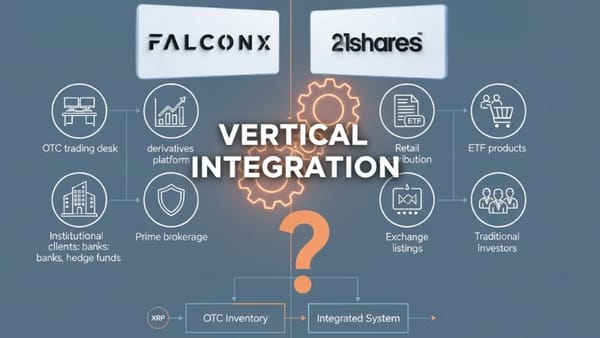AWS Outage: Which Crypto Networks Stayed Online?
Yesterday's AWS outage exposed crypto's centralization crisis. While 37% of Ethereum nodes went dark and major exchanges crashed, XRP Ledger maintained 100% uptime. The October 20 incident proved which networks deliver on decentralization promises—and which just market them.

Yesterday's massive Amazon Web Services outage exposed cryptocurrency's uncomfortable truth—most "decentralized" platforms still run on centralized cloud infrastructure.
The Outage That Tested Crypto's Foundation
On October 20, 2025, Amazon Web Services experienced a major outage in its US-EAST-1 region in Northern Virginia, disrupting services globally from the early morning hours through mid-afternoon. The root cause was DNS resolution issues affecting DynamoDB API endpoints, cascading across platforms that millions rely on daily.
Major platforms like Snapchat, Coinbase, Robinhood, Fortnite, Reddit, Venmo, and even Amazon's own Ring doorbell cameras experienced significant disruptions. Reports on Downdetector hit a high of over 50,000 reports starting around 7:50 AM ET. The incident sparked critical questions about cryptocurrency networks claiming decentralization while depending on centralized cloud providers—and revealed which projects actually built resilient infrastructure versus those that just marketed it.
XRP Ledger: The Network That Kept Running
While exchanges crashed and infrastructure providers struggled, the XRP Ledger continued closing blocks normally throughout the entire AWS outage. This wasn't luck—it was architectural design paying dividends when it mattered most.
Crypto commentator @Vet_X0 noted: "Despite AWS having issues, the XRP Ledger is closing blocks normally. That's the hard work of decentralization, especially geographical and hosting wise." XRPL currently operates with approximately 120-150 validators distributed across multiple hosting providers including AWS, Google Cloud, Hetzner, DigitalOcean, and independent servers.
This validator diversity proved critical. While AWS faced DNS and DynamoDB issues disrupting ChatGPT, Coinbase, Reddit, and Fortnite, XRPL maintained normal operations. The network's unique consensus mechanism doesn't require massive computational resources, allowing validators to operate on various platforms without single-point dependencies.
Real-world institutional validation: For financial institutions using RippleNet for cross-border payments, yesterday's outage served as real-world stress testing. Zero downtime during a major infrastructure failure demonstrates XRPL's suitability for mission-critical payment infrastructure where 99.99% uptime isn't aspirational—it's mandatory.
The XLS-50 advantage: The XLS-50 proposal encourages validators to publish details about their operational setup, promoting transparency around physical location, network (ASN), and cloud provider diversity. This proactive approach to infrastructure resilience differentiated XRPL from networks that discovered their centralization vulnerabilities the hard way.
Price and adoption implications: While XRP's market price didn't immediately surge following the outage, the incident provides fundamental support for long-term institutional adoption. As Ripple continues navigating its legal developments with the SEC, demonstrating superior operational reliability strengthens its regulatory compliance narrative and competitive positioning for enterprise partnerships.
Ethereum and Bitcoin: Partial Resilience with Vulnerabilities Exposed
Data from Ethernodes shows AWS hosts roughly 2,368 Ethereum execution layer nodes, accounting for approximately 37% of the network's total. This significant concentration created notable friction during the outage.
While Ethereum's core mainnet remained operational due to its distributed node architecture, AWS-dependent components experienced disruptions. The concentration level underlines how much "decentralized" crypto depends on centralized infrastructure pipes. The blockchain continued processing transactions, but ecosystem degradation affected user experience substantially.
Layer 2 networks hit hard: Base, Coinbase's Ethereum layer-2 network, reported that the AWS outage impacted its infrastructure and reduced capacity. Analysis showed Base lost 25% throughput when its AWS-hosted sequencer went down, while Arbitrum and Optimism stayed fully operational using multi-cloud setups. This stark difference in performance highlighted the value of multi-cloud architectural strategies.
Bitcoin's better distribution: Bitcoin's more extensive node distribution meant the AWS outage affected only a subset of network infrastructure. The Bitcoin node network spans thousands of independent operators worldwide, providing genuine redundancy. The blockchain continued producing blocks at regular intervals with miners operating on diverse hosting solutions. However, more than 30% of Bitcoin's hashrate is now based in the U.S., suggesting potential geographic centralization concerns that could become problematic in future regional disruptions.
The Infrastructure Provider Crisis: Infura's Cascading Failure
The Infura status page painted a stark picture of the cascading failure. At 07:16 UTC on October 20, Infura reported investigating outages across multiple Mainnet JSON-RPC API endpoints: Polygon, Optimism, Arbitrum, Ethereum, Infura-Linea, Base, and Scroll. The company acknowledged that infrastructure was experiencing an outage, with customers in Growth and Custom tiers having their traffic forwarded to infrastructure partners for failover protection.
By 07:27 UTC, Infura identified the issue and began implementing a fix. Full resolution came at 07:51 UTC—but the damage to user confidence was already done. The outage lasted approximately 35 minutes at the infrastructure level, though some users experienced longer disruption periods.
The MetaMask panic: MetaMask users saw erroneous zero balances due to Infura's inability to fetch real-time blockchain data, though actual funds remained secure on-chain. Screenshots from affected users showed error messages stating "Error connecting to the blockchain. Please try reloading the page" with failed fetch requests to Infura's mainnet endpoints showing HTTP errors and version information.
Gabriel Shapiro, a prominent attorney in the crypto space (@lex_node), tweeted: "anyone else log into metamask, see this because of infura AWS issue and have smol heartytack?" alongside a screenshot showing a zero balance. This panic—though funds remained secure on-chain—illustrates how centralized infrastructure dependencies undermine user confidence in supposedly "decentralized" systems.
The psychological impact cannot be understated. Users who believed their assets were stored on decentralized blockchains discovered that their ability to access those assets depended entirely on centralized infrastructure. The distinction between protocol-level decentralization and user-facing centralization became painfully clear.
The Exchange Disaster: Centralized Services Down
Coinbase and Robinhood, which derive substantial revenue from crypto trading, experienced significant outages. Coinbase Support posted: "We're aware many users are currently unable to access Coinbase due to an AWS outage. Our team is working on the issue and we'll provide updates here. All funds are safe."
Crypto traders found themselves unable to access accounts, process trades, or withdraw funds due to the AWS disruption. The largest U.S. cryptocurrency exchange, Coinbase, said its services were unavailable because of the outage, while trading app Robinhood and payments app Venmo also experienced issues.
For traders trying to capitalize on market movements or execute time-sensitive transactions, the outage was more than an inconvenience—it was a complete service failure. Customer support channels became overwhelmed with frustrated users unable to access their funds during critical trading hours.
The irony exposed: Pseudonymous trader @AltcoinPsycho wrote: "Gotta love seeing 95% of crypto down because of an AWS outage. Very decentralized - great work lads 👍". Despite being built on decentralized ideals, many blockchain projects still rely on AWS servers for operations, exposing a central point of failure.
The crypto community's response ranged from sardonic humor to genuine concern about the industry's architectural foundations. If a single cloud provider's regional failure could take down the majority of crypto services, what did that say about the industry's claims of creating an alternative to centralized financial systems?
NFTs Go Dark: The Ownership Illusion Shattered
Yesterday's AWS outage took NFTs on Ethereum offline, highlighting a fundamental flaw in the "ownership" model. When AWS crashed, NFT images stored on servers became inaccessible, raising questions about whether users truly "own" NFTs if third-party technical difficulties can block access.
This exposure revealed that many Ethereum NFTs store only token metadata on-chain, with actual image files hosted on centralized servers—defeating the decentralization premise that attracted users to blockchain-based digital ownership in the first place.
To be blunt, it's hard to claim that someone "owns" an NFT if third-party technical difficulties can block access. The sales pitch of NFTs—that blockchain technology provides real ownership of digital property on a decentralized system—proved hollow when users couldn't view their supposedly owned assets during the AWS outage.
This incident may accelerate the ongoing decline in NFT demand, as the fundamental value proposition appears compromised by infrastructure dependencies that contradict the technology's promises.
Why Everyone Flocked to AWS (And Paid the Price)
Running nodes in-house requires expensive hardware, stable electricity, and bandwidth—resources that large data centers provide at scale, making AWS cheaper, "reliable," and faster to deploy for start-ups. But that convenience trades resilience for efficiency, because overreliance on a few cloud providers creates structural risk.
The math seemed simple for crypto startups: spend months and hundreds of thousands of dollars building custom infrastructure, or spin up AWS instances in minutes with a credit card. For projects racing to market or operating on limited budgets, the choice felt obvious. The hidden cost—systemic risk and single points of failure—only became apparent during outages like yesterday's.
The timeline of failure: The outage lasted several hours, with AWS reporting increased error rates and latencies starting around 3:11 AM ET (11:49 PM PDT October 19), with recovery beginning around 5:27 AM ET, though some services took longer to stabilize. By 2:24 AM PDT October 20, AWS had worked through the core DNS resolution issues, but cascading effects continued impacting dependent services for hours afterward.
The financial toll: The financial impact will easily reach into the hundreds of billions due to loss in productivity for millions of workers and stopped or delayed business operations. For cryptocurrency platforms specifically, the outage occurred during active trading hours for East Coast U.S. users, potentially costing exchanges and traders significant revenue and opportunities.
XRP's Competitive Advantage Crystallizes
Yesterday's outage strengthened XRP's positioning for institutional adoption in several concrete, quantifiable ways:
Proven reliability under stress: XRPL's performance stood out as it kept closing blocks as usual while major platforms faced downtime. This real-world demonstration addresses financial institutions' primary concern about blockchain operational reliability. When evaluating technology vendors, enterprises require documented evidence of resilience—not promises or theoretical models.
Decentralization that actually works: XRPL's decentralized validator network and initiatives like XLS-50 ensure operational continuity when cloud providers fail. This isn't theoretical—it's documented performance under real stress conditions. The contrast between XRPL's continued operations and Coinbase's complete service failure provides a concrete case study for enterprise decision-makers.
Enterprise differentiation: While competitors discuss infrastructure improvements post-incident, XRPL demonstrated existing resilience. For CFOs and CTOs evaluating blockchain infrastructure, yesterday provided quantifiable proof that architectural decisions matter. The question is no longer "which blockchain claims the best infrastructure?" but rather "which blockchain proved its infrastructure works under real-world stress?"
Regulatory compliance narrative: With Ethereum staking dominated by Lido and big cloud operators, and Bitcoin facing similar centralization concerns, XRPL's uptime during the outage shows that more distribution makes a network harder to break. This operational superiority supports Ripple's regulatory positioning as the company navigates ongoing discussions with financial regulators globally.
Partnership acceleration: Companies using RippleNet for settlements experienced zero disruption yesterday. This operational track record becomes a powerful sales tool in enterprise adoption conversations. When presenting to risk-averse financial institutions, Ripple can now point to documented resilience during a major infrastructure failure that crippled competitors—a more compelling argument than any whitepaper could provide.
The Decentralization Reality Check
This statement captures the existential crisis facing the cryptocurrency industry. The fundamental promise—creating alternatives to centralized financial systems—rings hollow when most crypto platforms depend on the same centralized infrastructure as traditional web services.
The dependency on AWS and cloud-based infrastructure creates single points of failure, leading to widespread disruption whenever technical issues occur. The October 2025 AWS outage has sparked ongoing debates about the need for more diversified and resilient cloud strategies.
The architectural wake-up call: The outage reignited debate over the need for decentralized cloud compute systems that mimic AWS's functionality but distribute storage and processing across independent participants. Projects are now evaluating multi-cloud strategies, bare-metal server investments, and specialized blockchain hosting providers.
The challenge is substantial. Truly decentralized infrastructure is expensive, complex, and slower to deploy. It requires coordination across multiple providers, sophisticated failover systems, and constant monitoring. Many crypto projects lack the resources or technical sophistication to implement these solutions—which is precisely why they chose AWS in the first place.
What Investors and Users Should Learn
Yesterday's outage provided critical evaluation criteria for assessing cryptocurrency networks:
Test actual infrastructure, not marketing: XRPL's structure proves that careful network design and distribution can protect against large-scale outages. Claims about decentralization mean nothing without genuine validator and node diversity across multiple hosting providers, geographic regions, and ownership structures.
When evaluating crypto projects, ask: Where do validators actually run? What percentage depends on AWS or other single cloud providers? Is there documented geographic distribution? Can the network maintain consensus if a major cloud provider experiences regional failure?
Distinguish protocol from access layers: While Ethereum's core mainnet remained operational, AWS-dependent components experienced disruptions. A perfectly decentralized consensus mechanism doesn't guarantee user accessibility when infrastructure remains centralized.
This distinction matters enormously for practical use. A blockchain that continues processing transactions but renders wallets, exchanges, and dApps inaccessible delivers little value to users who can't actually interact with their assets.
Ecosystem dependencies matter: Even when blockchain protocols operate perfectly, if explorers, wallets, exchanges, and dApps go offline due to shared infrastructure, user experience suffers significantly. The weakest link determines system reliability.
Evaluate not just the base blockchain but the entire ecosystem: How do users typically access the network? What infrastructure do wallets depend on? Where do exchanges host their services? Are there redundant access methods if primary infrastructure fails?
Value demonstrated resilience: The XRP Ledger did not go down during the AWS outage, while services like Snapchat, Reddit, Coinbase, and Ethereum tools experienced disruptions for several hours. Operational track records under stress reveal truth that marketing materials obscure.
Past performance during infrastructure failures provides the most reliable indicator of future resilience. Projects that maintained operations during yesterday's outage earned credibility that cannot be manufactured through whitepapers or promotional campaigns.
Consider institutional requirements: Enterprises evaluating blockchain adoption have non-negotiable uptime requirements. Systems that failed yesterday don't meet institutional standards, regardless of their features or marketing claims. XRPL's demonstrated resilience positions it favorably for enterprise adoption conversations that competitors will struggle to match.
Looking Forward: Infrastructure as Competitive Advantage
AWS doesn't often experience major disruptions like this, with the last significant one occurring in 2021. But yesterday's incident serves as a reminder that the internet is a complex web of overlapping services that are only as reliable as their weakest code.
The infrequency of major AWS outages actually makes them more dangerous for systems that haven't properly prepared. Organizations become complacent when infrastructure "just works" for years, neglecting redundancy planning until a crisis exposes their vulnerabilities.
For crypto platforms and investors, XRPL is a lesson in resilience—centralized cloud services are convenient but fragile. In a world where one cloud failure can ripple across millions of users, XRP Ledger is setting the bar: decentralized networks can, and do, work better.
The path forward: Organizations are now evaluating infrastructure alternatives:
- Multi-cloud architectures: Distributing services across AWS, Google Cloud, Microsoft Azure, and others to eliminate single points of failure
- Bare-metal deployments: Investing in owned hardware to reduce cloud provider dependency entirely
- Specialized blockchain infrastructure: Services like dedicated blockchain hosting providers offering redundancy designed specifically for crypto workloads
- Geographic distribution: Ensuring critical services span multiple regions and continents
- Automated failover systems: Implementing sophisticated traffic routing that automatically redirects users when infrastructure fails
The crypto projects that internalize yesterday's lessons and invest in genuine infrastructure resilience will gain competitive advantages as the industry matures and institutional adoption increases.
The Bottom Line
As cryptocurrency moves toward mainstream adoption, operational resilience will increasingly differentiate winners from losers. Networks like XRP Ledger that demonstrated architectural advantages during yesterday's stress test have strengthened their competitive positions significantly.
Yesterday's scorecard:
- XRP Ledger: 100% operational throughout the entire outage
- Bitcoin: Largely operational with minor ecosystem friction
- Ethereum: Core network operational, but 37% node dependency caused ecosystem degradation
- Layer 2 networks: Base lost 25% capacity; Arbitrum and Optimism maintained operations with multi-cloud setups
- Exchanges: Coinbase and Robinhood experienced complete service failures
- Infrastructure providers: Infura down for 35+ minutes, cascading to MetaMask and multiple chains
- NFTs: Inaccessible, exposing centralized storage dependencies
The crypto industry markets itself as the future of decentralized finance—a trustless alternative to centralized institutions. Yesterday's AWS outage revealed how far reality diverges from that vision. Most crypto platforms failed the infrastructure stress test, exposing single points of failure that contradict fundamental blockchain principles.
XRPL passed. That distinction matters.
When AWS went down yesterday, XRPL stayed up. That sentence contains more institutional value than a thousand whitepapers claiming decentralization.
DISCLAIMER: This newsletter is for informational purposes only and does not constitute investment advice, advertising, or a recommendation to buy, sell, or hold any securities. This content is not sponsored by or affiliated with any of the mentioned entities. Investments in cryptocurrencies or other financial assets carry significant risks, including the potential for total loss, extreme volatility, and regulatory uncertainty. Past performance is not indicative of future results. Always consult a qualified financial professional and conduct thorough research before making any investment decisions.
Sources
- AWS Service Health Dashboard - October 20, 2025
- Tom's Guide: AWS Outage Live Updates
- TechCrunch: Amazon Identifies Issue That Broke the Internet
- CNN: Why Internet Outages Keep Happening
- CoinPedia: XRP Ledger Stays Strong During AWS Outage
- U.Today: XRP Ledger Turns AWS Crash into Case for More Decentralization
- Fortune Crypto: Coinbase, Robinhood Down as Amazon Outage Cripples Internet
- CryptoSlate: How AWS Glitch Took Down Coinbase, ETH L2s, and Half the Internet
- Al Jazeera: Amazon Web Services Recovered from Global Web Outages
- NBC News: Major AWS Outage Takes Down Web Services
- TheStreet Crypto: AWS Outage Cripples Major Crypto Exchanges
- CCN: Amazon's AWS Outage Knocks Coinbase, Robinhood Offline - Full List
- CryptoNews: Major Online Platforms Face Outages - Coinbase Affected
- BeInCrypto: Amazon's AWS Outage Exposes Flaw of Ethereum NFTs
- Bitcoin Ethereum News: AWS Outage Persists, Potentially Disrupting Ethereum
- Ethernodes: Ethereum Node Distribution Data
- Bitnodes: Bitcoin Network Statistics
- XRP Ledger: Consensus Protocol Documentation
- RippleNet Overview
- SEC v. Ripple Labs Litigation
- Mashable: AWS Outage Update - What Happened and Why
- Yahoo Finance: Amazon AWS Outage Exposes Major Vulnerabilities
- Axios: AWS Outage Hits Reddit, Roblox, Coinbase
- Infura Status Page: Mainnet JSON-RPC API Outage Documentation
- Bitget Academy: AWS Outage Shakes Crypto
- OpenTools AI: AWS Outage on October 20, 2025
- TradingView News: XRP Ledger Stays Strong
- X/Twitter: @DoesDenny on XRPL Resilience
- X/Twitter: @Cryptoinparadiz on Ethereum Risk



